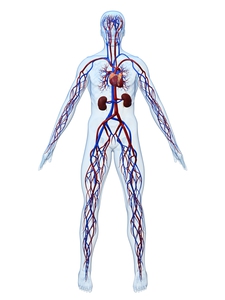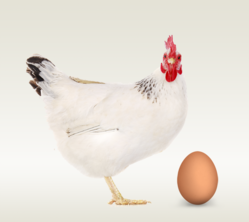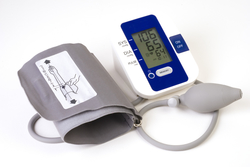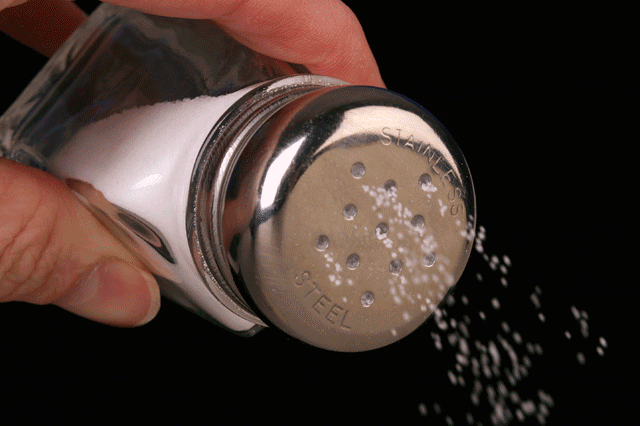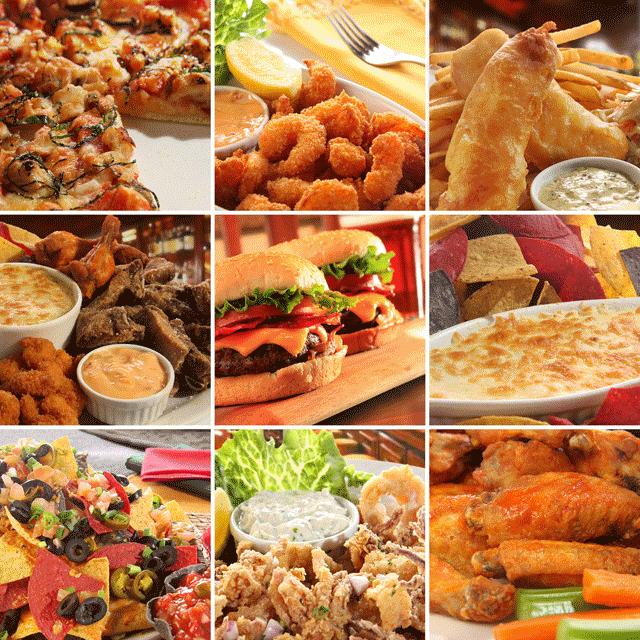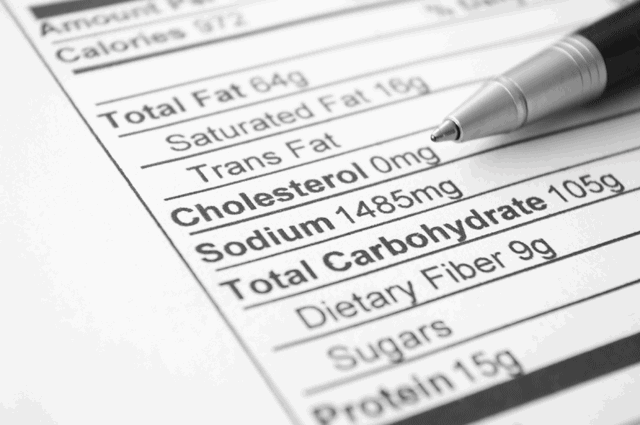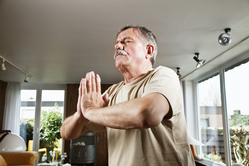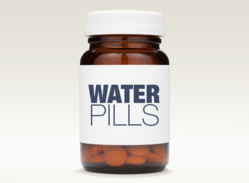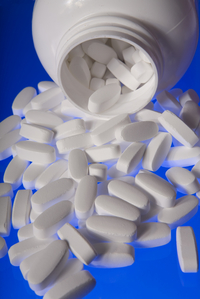High Blood Pressure and Kidney Disease
High blood pressure is the number two cause of kidney failure in the U.S., after diabetes. If you have high blood pressure and kidney problems, there are steps you can take. The goal is to help your kidneys live as long as you do.
Arteries, Veins, and Blood Pressure
You have two types of blood vessels. Arteries, shown in the picture in red, take blood from your heart (with oxygen from your lungs) to the rest of your body. Veins, shown in the picture in blue, bring blood back to the lungs to pick up more oxygen. Arteries are strong and flexible. But, as we age, they can become stiff. This is one cause of high blood pressure.
When blood pressure is high, the force of blood against the walls of your arteries can harm small blood vessels—like a tire blowout. The tiny filters inside the kidneys are small blood vessels. This is why high blood pressure can harm them.
High Blood Pressure and Your Kidneys
High blood pressure can harm kidneys. And, damaged kidneys can stop doing a good job of keeping blood pressure under control. Like the chicken and the egg, doctors can't always tell which came first.
In most cases it is possible to lower blood pressure and protect the kidneys from more damage. Good blood pressure control also helps reduce your risk of a heart attack or stroke.
Know Your Blood Pressure and How it Reacts
Knowing your blood pressure is the first step to getting it in control. Ask your care team what your blood pressure goal should be. A home blood pressure cuff is a great tool to have, and your VA care team can give you one. Then you can:
- Check your blood pressure when you are sitting quietly at rest.
- Check your blood pressure if you feel faint or have a headache.
- Write down the results and look for patterns. These can help your doctor.
- Let your care team know your numbers.
- Bring a record of your numbers to your next care team visit.
Put Away the Salt Shaker
If you are salt sensitive, eating less salt, or sodium, can help you bring down your blood pressure. Sea salt is just the same—and just as harmful for you—as table salt. Salt substitutes may be high in potassium, which is dangerous for you if your kidneys can't remove it from your body. It's better to use herbal seasonings, which come in lots of low-salt flavors.
Most sodium comes from processed foods that come in cans, bags, or boxes. Food from restaurants also tends to be much higher in sodium than fresh foods that are cooked at home.
The American Heart Association says we should ALL limit sodium in our diets to 1,500 milligrams (mg) per day. Many people find that once they get used to eating less salt, food tastes better.
Avoid High-Salt Fast and Processed Foods
Did you know that many Americans eat fast food every day? A lot of fast food is very high in salt—along with fat, trans fats, starch, and calories. It's cheap and tasty, but not good for you OR your kidneys. You can get a whole day's worth of salt, sugar, and fat with just one menu item! At restaurants where they cook to order, you can ask for food with no added salt, MSG, salty sauces, or cheese on top. This can help you control your blood pressure.
About ¾ of all salt in most people's diets comes from processed foods. These have been changed in some way—cooked, frozen, dehydrated. Soups often have a lot of sodium—look for low sodium soups. Most processed meats, like bacon, cold cuts, and salami have too much salt to be good choices.
Read ingredient lists on ALL meats. Some fresh meats are injected with salt or potassium. You don't want to see the word enhanced on the label. Avoid these. Condiments, like ketchup and soy sauce, have a lot of salt. Boxed side dishes and "helper" foods have too much salt. If you have high blood pressure, these are not a good choice. To learn more about salt in foods, visit the Nutrition Room.
Read Food Labels to Look for Sodium
Does the food in this label look like a good choice to protect your kidneys? There is almost 1,500 mg of sodium in one serving of this food—a whole day's worth.
Most foods have labels like this to help you make good choices. Keep a close eye on serving sizes:
- A serving size may be in grams or ounces
- A food that comes in a bag could be two or three servings, not one
- If you eat more than one serving, you get more salt
To learn more about salt and chronic kidney disease, read Sodium: Tips for People with Chronic Kidney Disease (CKD)* from the National Kidney Disease Education Program (NKDEP).
* Links will take you outside of the Department of Veterans Affairs website. VA does not endorse and is not responsible for the content of the linked websites.
Treat High Blood Pressure with Lifestyle Changes
Eating right and staying active can help you stay in your target blood pressure range. Weight loss if you are overweight can help lower your blood pressure. These things are in your control. No one else can eat or exercise for you.
Based on your kidney function, you may need to limit foods that are high in potassium—like coffee, milk, bananas, orange juice, tomatoes, and potatoes. Talk to a VA dietitian about the best food choices for you.
Visit MOVE!®, a VA program to help you get started with exercise and weight management.Diuretics ("Water Pills") Are Often the First Type of Blood Pressure Pills Used
Blood pressure pills are often prescribed to help lower blood pressure. The first line of treatment is often diuretics (water pills). These help your kidneys get rid of extra water and sodium in your body by helping you make more urine. Diuretics only work while your kidneys still have some function.
Of course, pills only work if you take them. If side effects or cost keep you from taking meds, talk to your health care team. You may be able to take your pills at a time of day that will be less of a problem for you (so you don't have to wake up at night to use the bathroom). Or, there may be other drugs that will not cause problems for you.
Some Blood Pressure Pills Can Help Protect the Kidneys
Two types of blood pressure pills can help protect the kidneys:
- ACE-inhibitors – the generic name ends in “pril”
- Angiotensin receptor blockers (ARBs) – the generic name ends in “sartan”
These are very helpful in diabetes or diseases where there is protein in the urine. An ACE-inhibitor can cause a nagging, dry cough. If this happens, you may need to switch to an ARB. Not on an ACE-inhibitor or an ARB? Ask your doctor if one might help you. If you have side effects from blood pressure pills (like erectile dysfunction), tell your doctor. There may be others you can try.

You've reached the end of this topic:
How to Slow CKD When You Have High Blood Pressure
- High blood pressure can damage kidneys by
Not scored High blood pressure can cause the tiny kidney filters to blow out—like a bad tire. You can protect your kidneys by keeping your blood pressure in the target range your doctor sets.
- It’s wise to check your blood pressure at home so you can:
Not scored Your doctor only sees your blood pressure when you are in the office. But the pattern of blood pressure may be a helpful clue your care team can use to help protect your kidneys.
- It’s best to avoid fast food when you have high blood pressure because:
Not scored Fast food can be sugary, fried, very salty, and high in calories. Eating it may raise your blood pressure and cause or worsen other health problems.
- These tasks can help you lower your blood pressure:
Not scored Moving your body—and calming your mind—can both help lower blood pressure.
- You may need to take more than one type of pill to control your blood pressure with kidney disease:
Not scored Keeping your blood pressure in control can help protect your kidneys. So, it’s worth it to take more than one blood pressure pill if your doctor prescribes it.














